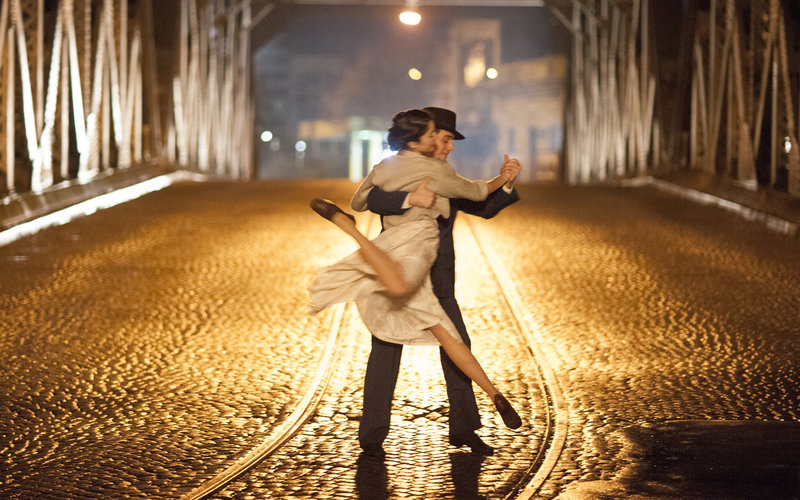The Wim Wenders produced OUR LAST TANGO, by German Kral, reconciles art with life and narrative cinema with documentary. The lives are those of María Nieves Rego and Juan Carlos Copes, probably the longest enduring couple in Argentine tango as a performing art. I am careful how I put that, because there are social dance couples too, and types of tango that are not Argentine, with their own couples. They related, in any case, onstage and off, for half a century, with breakups in both that didn’t necessarily correlate. He invented (I don’t know of a counter-narrative) the tango show, with a structure that lasts to this day, first conquering Avenida Corrientes in Buenos Aires, the South American equivalent to Broadway or the West End, then Broadway itself, most famously as choreographer of the Parisian import Tango Argentino in 1983. She was, in the patriarchy in which they flourished, his muse, or, as he puts it in the film, the “Stradivarius” that he, as the lead, played. He did not, by any fair account, treat her decently in the personal realm, although he seems (and probably is) a decent man, and it is around that irony that the film gathers its power and fascination.
A corps of dancers is compiling material for a recreation of Nieves and Copes’ lives, personal and artistic. Documents are pored over (photographs, newspaper clippings, film of their performances, clips from his popular TV show) and the couple, along with friends, family and associates, are interviewed. He is taciturn and enigmatic; she is, for all intents and purposes, the film’s narrator, and it is her story that prevails. There is a soundstage through which she wanders, wistfully, of the locales of their story, fingering the props as though they were artifacts, and she revisits some of the tango sites that the couple haunted in the ’50s: nostalgia is at its height not when a place has vanished but when it is marked by change. Still larger changes are marked by some of the crispest aerial shots of Buenos Aires I’ve seen. They are, if one knows the city, ironically pristine, as stage tango in comparison to the social. It is as though to say that the city is worthy of the art it is most known for: glamorous and, in its stories, infinite.
Kral fades to the past with a fictive grace that softens the boundary between cinematic flashback and musical drama. When Juan Malizia, as Copes, meets Ayelén Álvarez Miño, as Nieves, in one of the milongas they went to as adolescents, it is more dream than reenactment. It’s brilliantly stylized, and witty; they play, as only skilled artists could, a young tanguero not yet secure in his lead and a young woman (not yet a tanguera) who doesn’t know the first thing about following. The awkwardness is exaggerated to exactly the right degree; it is, if one knows tango, funny not just on its own terms, but because it is recognizable. Later, as a more skilled Nieves and Copes, they tango in the rain, playfully aware of the special effects, calling to mind, although they are a couple, the Gene Kelly solo, their tango uncannily like his improvised masterpiece. The choreography, in all the film, plays with surprise. There’s a scene of Malizia and Álvarez shot from the knees down in which her feet come literally off the ground: one assumes that he is lifting her, but when the shot pulls back, something else entirely turns out to have been happening, courtesy, no doubt, of Brenda Angiel, the aerial tanguera who is one of five credited choreographers.
The work by Alejandra Gutty and Pablo Verón as the somewhat older Nieves and Copes is stylized in a different way. The expressive Gutty looks a lot like Nieves, and Verón alludes to Copes’ style, posture and footwork. The real Nieves, coaching them, provides a mini-history of tango’s transition from social dance to theater, the intimacy of the embrace opening to accommodate the showier moves. Some of those, we hear from Nieves and see in archival footage, were both virtuoso and harrowing, to her, to perform, such as dancing breakneck on a café table, the which, she confesses, terrified her on each occasion. The new choreography juxtaposes easily with the film of Nieves and Copes, never inviting an unfavorable comparison. Neither naturalistic imitation nor homage, it works as a story remembered and retold, with fondness, imagination, and respect.
Nieves and Copes, now in their early 80s, are shown dressing and making up as though for a reunion, and we do see them step onto the same stage. But the last tango, or “one tango more” (in Spanish, Un tango más) of the title is, on some level, the film we are watching, the interplay of a lively, expressive woman with an impassive but elegant man, the personal in dialogue with culture and art, different only in kind from the tango itself.
Check listings for viewing options.
